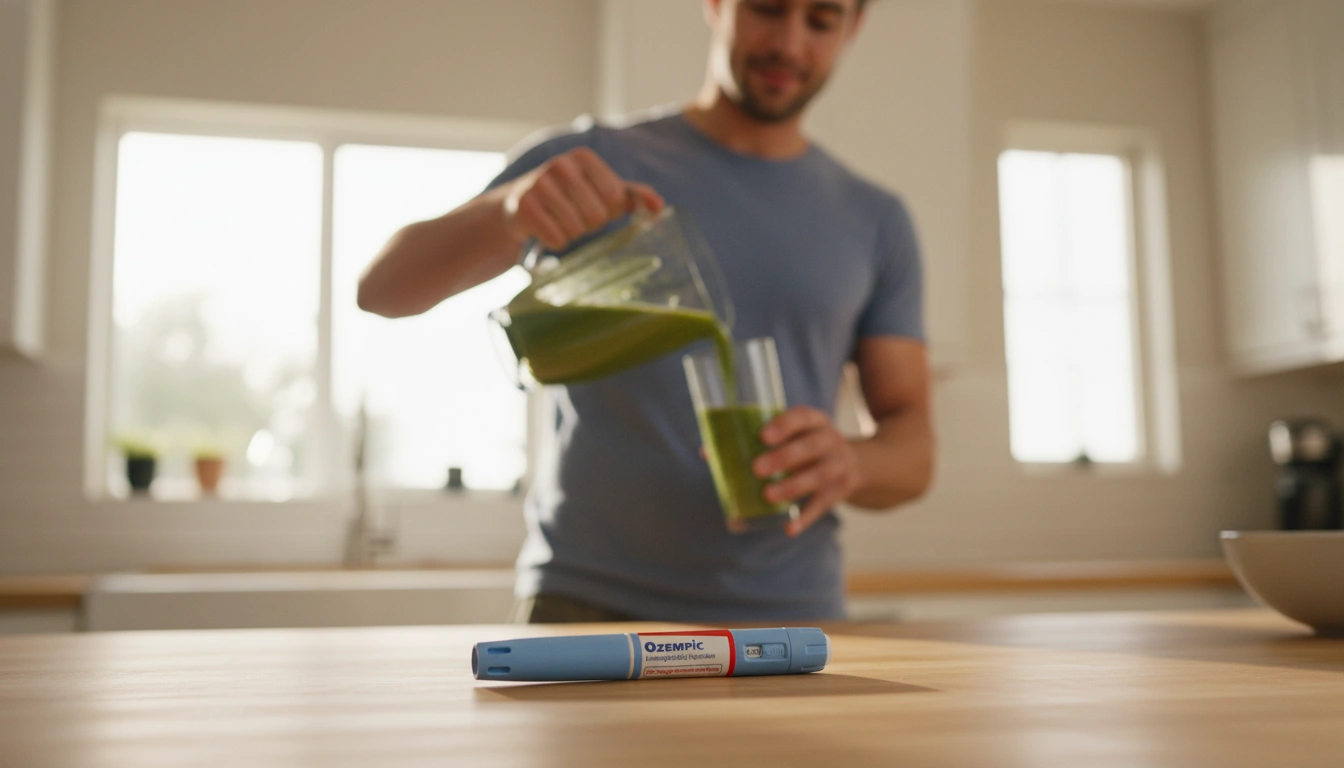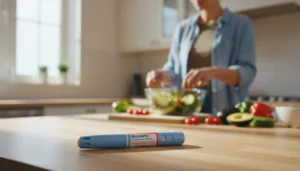Understanding What Are the Doses of Ozempic: A Guide to Effective Use

Introduction
What if a once-weekly injection could help manage your blood sugar and support weight control? This possibility has become a reality for many people with type 2 diabetes, thanks to medications like Ozempic®. Yet, understanding what are the doses of Ozempic and how they work is crucial for anyone considering or already prescribed this treatment.
Ozempic®, an FDA-approved injectable medication containing the active ingredient semaglutide, has revolutionized how type 2 diabetes is managed. Its extended-release formulation allows for weekly dosing, addressing blood sugar regulation and reducing cardiovascular risks. This medication’s dosing strategy balances efficacy and tolerability, ensuring users get the best benefits while minimizing side effects.
Together, we'll explore the nuances behind Ozempic's dosing schedule, the reasoning behind incremental dose increases, and how personalized care plays a role. We’ll unpack aspects including starting doses, maintenance dosages, special considerations for kidney disease, injection techniques, and troubleshooting missed doses. By the end, you’ll have a clearer, comprehensive understanding that empowers you or your loved ones to navigate Ozempic use confidently.
Moreover, we’ll touch on how personalized weight loss programs, like those offered by TrimRx, integrate medications like Ozempic safely and effectively—helping craft individualized plans that move beyond the pill to support sustained wellness. Whether you're new to Ozempic or want to optimize your regimen, this guide uncovers the essential dosing insights that matter most.
What Exactly Is Ozempic, and How Does Dosage Impact Its Benefits?
Ozempic is a prescription medication belonging to a class called GLP-1 receptor agonists. It mimics a natural hormone involved in appetite regulation and insulin secretion, producing dual effects:
- Helping the pancreas secrete insulin when blood sugar rises.
- Slowing gastric emptying and reducing appetite, sometimes leading to weight loss.
Since diabetes management requires steady and consistent blood sugar control, dosing is designed to maintain optimal medicine levels in the body without overwhelming the system.
Why Does the Dose Matter?
The right dose achieves a balance between therapeutic effect and side effect management. For example, starting at a low dose helps reduce common side effects like gastrointestinal discomfort—nausea, vomiting, and diarrhea—which may occur when the body is first exposed to the drug. Gradually increasing the dose allows users to acclimate without severe adverse reactions.
Moreover, individual factors such as kidney health, additional medications, and personal response influence dose adjustments.
The Standard Ozempic Dosing Schedule: Step by Step
Understanding what are the doses of Ozempic means knowing the typical progression and the reasoning behind each step. Ozempic is administered once weekly via subcutaneous injection (under the skin), using a prefilled disposable pen.
1. Starting Dose: 0.25 mg Once Weekly for 4 Weeks
- Purpose: This initial dose is not intended to manage blood sugar effectively but to help your body adjust to the drug and reduce gastrointestinal side effects.
- Why It Matters: Jumping directly to higher doses increases the likelihood of nausea and vomiting.
2. Maintenance Dose: 0.5 mg Once Weekly for at Least 4 Weeks
- After the initial 4 weeks, the dose is raised to 0.5 mg, the dose at which some blood sugar management effects begin.
- This dose should be maintained for a minimum of 4 weeks—allowing the body to continue adjusting.
3. Dose Escalation to 1 mg or 2 mg Once Weekly (If Needed)
- Depending on your blood sugar targets and tolerance, your healthcare provider may increase your dose to 1 mg.
- For additional control, a further increase up to 2 mg once weekly might be prescribed.
- Maximum Dose: 2 mg once per week, which is the highest approved for diabetes treatment.
How Are Dose Increases Managed?
Dose changes occur in four-week intervals to allow the body time to adapt. The gradual rise also helps identify the smallest effective dose you need for managing your condition.
Summary of Ozempic Dose Progression
| Dose | Frequency | Purpose | Time Frame |
|---|---|---|---|
| ———– | —————- | ———————————————— | —————————– |
| 0.25 mg | Once weekly | Initial dose to reduce side effects and acclimate | First 4 weeks |
| 0.5 mg | Once weekly | Maintenance dose with blood sugar control | Weeks 5–8 |
| 1 mg | Once weekly | Further control for blood sugar and cardiovascular risks | After 8 weeks (per doctor) |
| 2 mg | Once weekly | Maximum dose for optimal glycemic control if needed | As directed by healthcare provider |
Injection Guidance: Where and How to Use Ozempic Pens Safely
How a medication is taken is as important as the dose itself. Ozempic pens deliver semaglutide via subcutaneous injections in easy-to-use, prefilled pens.
Recommended Injection Sites
- Abdomen (stomach area)
- Thigh (front)
- Upper arm (outer area)
Rotating injection sites helps prevent skin irritation and localized side effects. It’s recommended to alternate the site weekly or choose different spots within the same area.
Timing and Routine
- Ozempic is typically taken once per week, on the same day and time, to maintain consistent blood drug levels.
- The injection can be administered with or without food and at any time of day.
- If your schedule changes, ensure at least 48 hours (2 days) between doses.
Preparing the Pen
- Use a new needle for each injection to reduce risk of infection and blockage.
- Before the first injection with a new pen, check the flow by selecting the flow-check symbol to ensure proper medication delivery.
- After injecting, properly dispose of needles and pens following FDA-approved sharps disposal guidance.
What To Do If You Miss a Dose?
Missing a dose can happen, and knowing how to respond is vital for maintaining effectiveness and safety.
- If less than 5 days (120 hours) have passed since your missed dose: Take the missed dose as soon as you remember.
- If more than 5 days have passed: Skip the missed dose and take the next dose on your originally scheduled day.
- Never take two doses within 48 hours to avoid overdose or increased side effects.
- Use reminders, such as phone apps or alarms, to support adherence.
Special Considerations for Kidney Disease and Other Health Conditions
The management of dosing may require special attention for people with conditions like chronic kidney disease (CKD).
- Ozempic has been FDA-approved to reduce the risk of worsening kidney disease in adults with type 2 diabetes and CKD.
- Initial dosing often remains the same, but dosing escalation might be more cautious.
- Patients with renal impairment should be monitored closely for side effects, especially dehydration-related effects from nausea or vomiting.
- Always disclose your full medical history and current medications to your healthcare provider to ensure safe dose planning.
Personalizing Ozempic Treatment: Why One Size Does Not Fit All
Not everyone responds to medications the same way, and this is where TrimRx’s personalized weight loss programs stand out. Our approach integrates clinical expertise with telehealth innovations to develop a tailored plan based on your unique health profile, lifestyle, and treatment goals.
For example, if you're considering Ozempic or similar medications (including compounded or oral semaglutide), taking our personalized assessment quiz (available here) can help identify whether you qualify for these therapies and what dosage may suit your needs.
This customized strategy helps:
- Optimize dosing schedules for effectiveness.
- Monitor tolerability to minimize side effects.
- Incorporate complementary support such as GLP-1 Daily Support and Weight Loss Boost supplements (discover here, and here) to enhance overall weight management.
By combining cutting-edge science, empathy, and personalized service, TrimRx fosters sustainable weight loss anchored in safety and clarity.
Common Questions About Ozempic Dosing
Can Ozempic be taken more than once a week?
No. Ozempic is designed as a once-weekly injection. Taking it more often may increase the risk of side effects.
What if I experience side effects such as nausea?
Starting at a low dose reduces these effects, but if they persist or worsen, consult your healthcare provider. Sometimes dose adjustment or slower escalation is needed.
Can I inject Ozempic in the same spot every week?
No. Rotate injection sites between abdomen, thigh, and upper arm to prevent injection site irritation.
Is 2 mg the highest dose available for Ozempic?
Yes. The maximum approved dose for Ozempic in managing type 2 diabetes is 2 mg once weekly.
How does Ozempic compare to Wegovy for weight loss?
While both contain semaglutide, Wegovy is specifically FDA-approved for chronic weight management and can be dosed higher. Ozempic's doses focus on blood sugar control but weight loss is a common beneficial side effect.
How do I handle a missed dose?
Take the missed dose within 5 days if you remember, otherwise skip it. Do not double up doses.
Bringing It All Together
Understanding what are the doses of Ozempic is a foundational step in managing type 2 diabetes effectively and safely. The dosing schedule—starting low, gradually increasing, and adjusting as needed—is designed to maximize benefits while minimizing side effects.
Using Ozempic involves more than just injecting the correct dose. Injection technique, timing, and individualized considerations all intertwine to influence outcomes. Personalized programs like those offered by TrimRx complement medication by providing comprehensive, empathetic care tailored for each individual’s unique weight loss journey.
By committing to a consistent routine, communicating openly with your healthcare provider, and taking advantage of supportive resources, you can unlock Ozempic’s potential in managing blood sugar and supporting a healthier lifestyle.
Ready to see if Ozempic or other prescription weight loss medications suit your journey? Try our free personalized assessment quiz here. For instant support, consider our quick-access supplements such as GLP-1 Daily Support or Weight Loss Boost to enhance your wellness while exploring medical options (check them out, or here).
Your path to sustainable weight management starts with knowledge and personalized care.
FAQ
Q1: What is the initial dose of Ozempic, and why is it so low?
A: The starting dose is 0.25 mg once per week for the first 4 weeks. This low dose is intended to allow your body to adjust to the medication and reduce common side effects such as nausea.
Q2: How often do I need to increase my Ozempic dose?
A: Typically, dose increases occur every 4 weeks based on tolerance and blood sugar response. The dose may be increased from 0.25 mg to 0.5 mg, and eventually to 1 mg or 2 mg if needed.
Q3: Can Ozempic be used for weight loss?
A: While Ozempic is FDA-approved for type 2 diabetes, weight loss is a common side effect. For formal weight management, medications like Wegovy (which contains the same active ingredient) are specifically approved.
Q4: What should I do if I miss an Ozempic dose?
A: If you remember within 5 days of the missed dose, take it as soon as possible. If more than 5 days have passed, skip the missed dose and take the next dose on schedule. Do not take two doses close together.
Q5: Where can I inject Ozempic?
A: Ozempic may be injected subcutaneously in the abdomen, thigh, or upper arm. Rotate injection sites regularly to avoid irritation.
Q6: Can I use Ozempic if I have kidney disease?
A: Yes, Ozempic is often used safely in patients with kidney disease, but dose adjustments and close monitoring may be necessary. Consult your healthcare provider for guidance.
Q7: How long does an Ozempic pen last?
A: The number of doses per pen depends on the prescribed dose. Typically, a pen may last around 4 weeks for a 0.5 mg weekly dose.
Q8: What are common side effects of Ozempic?
A: Common side effects include nausea, vomiting, diarrhea, abdominal pain, and constipation. Most side effects decrease as your body adjusts.
For personalized guidance on starting or optimizing your Ozempic treatment combined with a comprehensive weight management plan, visit TrimRx’s free assessment quiz. Explore supportive supplements designed to complement your journey with GLP-1 Daily Support and Weight Loss Boost.
TrimRx is dedicated to helping you safely and effectively achieve your weight loss goals through personalized, medically informed care tailored uniquely to you.

Transforming Lives, One Step at a Time
Keep reading
Navigating Your Treatment: How Many Pens in an Ozempic Box and What It Means for Your Health Journey
Curious how many pens in an Ozempic box? Our guide breaks down Ozempic pen strengths, doses, and how TrimRx supports your weight management journey. Click to learn more!
Empowering Your Health: A Comprehensive Guide on How to Use Ozempic Pens Effectively
Learn how to use Ozempic pens safely and effectively with our step-by-step guide. Master preparation, injection, & disposal for your weight management journey. Get expert tips!
Understanding Your Ozempic Pen: How to Tell When It’s Empty
Wondering how do I know when my Ozempic pen is empty? Learn key indicators, the dose counter trick, and proactive tips for consistent dosing.



